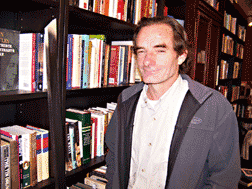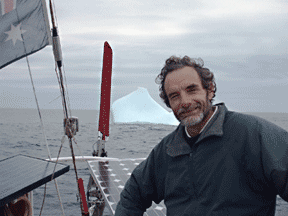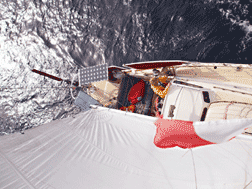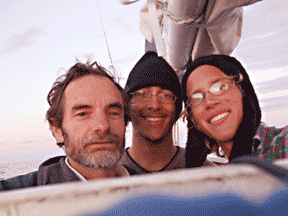How one Annapolis sailor sought adventure and global truth
by Carrie Madren
Bay Weekly Writer
 When Annapolis Bookstore wrapped up its book group on the whale tale Moby Dick, general manager Bob Williams had just returned from his own adventure on the high seas. Like the fictional Pequod and its crew, Williams set sail in search of a giant of the sea. His ship, Sylph sought icebergs, not whales.
When Annapolis Bookstore wrapped up its book group on the whale tale Moby Dick, general manager Bob Williams had just returned from his own adventure on the high seas. Like the fictional Pequod and its crew, Williams set sail in search of a giant of the sea. His ship, Sylph sought icebergs, not whales.
“It was a long trip, we had engine trouble, lack of wind and fog … but we eventually found our iceberg,” Williams says.
The difficulties of this voyage brought not disaster but an adventure rich with the rewards of difficulties overcome on the way to realizing a goal.
The 70-day northern adventure aboard Sylph, Williams’ 41-foot Alan Payne sloop, was a multi-purpose journey: First, to spy an iceberg, just because, he says, he’s never seen one. Second, to bring attention to global warming, a cause Williams has taken with serious intent. The journey — which led Sylph to aid a sinking boat and to sail alongside surfacing whales — was also a quest to uncover truths about climate change.
Williams, who has sailed around the world, is flying to Australia on November 4 to be a skipper with Young Endeavour, a tall-ship sailing program that takes Australians aged 16 to 23 on voyages around Australia or overseas. Local 2007 graduates Paul Wheatley and Erin Dowd of Annapolis High School and Max Heimberger of Severna Park High School served as mate along various legs of this 3,466-mile voyage.
Iceberg Ahead
When the 49-year-old Australian set sail from Spa Creek on July 12, Greenland was his goal. A late start followed by engine problems at St. John’s, Newfoundland, convinced him that a trip to Greenland — over 2,000 miles away — would be too rushed. So Williams settled on a shorter trip, circumnavigating Newfoundland to search for his iceberg.
“I’d seen them in pictures and thought, this looks pretty awesome,” he says.
 Williams increased his chances of spotting an iceberg by steering north of Newfoundland — through waters known as Iceberg Alley — where currents bring in chunks calved from Greenland glaciers.
Williams increased his chances of spotting an iceberg by steering north of Newfoundland — through waters known as Iceberg Alley — where currents bring in chunks calved from Greenland glaciers.
A tip from the Canadian government’s ice service clued the crew into an iceberg-dense area. Then three iceberg reports from other boaters in that same area lured Sylph outside of Notre Dame Bay, north of Newfoundland.
There are icebergs reported to be in the area, apparently four in about a 1,200-square-mile patch of ocean, Williams wrote in his online blog on August 13. We figure that at an average speed of four knots and a visual sweep width of about 10 miles, we can cover about 560 square miles in 14 hours of daylight.
Williams figured right.
That day, he and Wheatley spotted a tiny white dot on the horizon, about five miles away. They sailed closer, drawing near in about an hour and a half. What they found, instead of a drifting giant, was a churning, icy mass; the iceberg’s unstable size and shape made it come alive in the moving currents.
“The whole iceberg was rolling over and rolling back,” says Williams, who tacked his boat until he got within 20 feet of it. “This nodule on top made it look like a nuclear submarine; then it shifted and reminded me of a swan.” When the berg rolled over, it looked like a pyramid.
Wheatley named the iceberg Proteus, for the shape-changing old man of the sea in Homer’s Odyssey.
To remember the icy grail, they hauled aboard a watermelon-sized ice chunk that broke free from Proteus.
Williams still has that ice chunk, which he stores in his sailboat’s freezer. What will he do with a frozen souvenir?
Williams has a cool plan he hopes to share with bookstore patrons: Make iceberg martinis.
Spreading the Gospel
The siren call of curiosity lured Williams to Arctic waters, but his mission extended further. To spread the gospel of global warming awareness, the bibliophile delivered 10 signed copies of Al Gore’s An Inconvenient Truth to northern neighbors in and on the way to Newfoundland.
“I dropped them off at various locations — a coffee shop, a library and a marina office,” says Williams, whose job keeps him surrounded by books at the two Annapolis Bookstores. His gifts are meant to be shared from reader to reader, traveling like vagabond tomes. Each copy has an identity number, registered at www.bookcrossing.com, a website that tracks literature released into the wild. Once a reader finishes a book, he or she jots a note inside, records the book’s location online, then passes the book on to a friend — or a stranger.
In releasing Gore’s book, Williams hopes to put climate change on readers’ minds and in their conversations.
Through his own conversations with Canadians, Williams heard new testimony to global warming. He met Newfoundlanders who report fewer icebergs passing through in the summertime than in years past. Southbound icebergs — from Greenland — now often melt before they reach the Gulf of Labrador. Proteus was the only iceberg spotted by Williams during his 42-day circumnavigation.
A Lewisporte marina worker told Williams that when he was a child, his father used to drive him across the ice to Twillingate, some 30 miles north. Because the ice has melted, it’s open water now, according to Williams’ source.
“There’s lots of anecdotal evidence that we’re clearly in a warming phase,” Williams says. On this trip and others sailing around the world, he says he’s seen widespread evidence of human development waste and destruction of habitat.

Studying for the Great Debate
That’s more evidence, supporting his wide reading, to convince the literary maven that we need to pay attention to global warming.
Williams’ self-assignment on his journey was to sift through science that argues for or against global warming. He read, for example, climatologist S. Fred Singer and Dennis T. Avery’s book Unstoppable Global Warming, which argues that there is no scientific consensus on climate change.
As well as conflicting conclusions, the global debate on climate change, he says, is also weighted with political pressure and apathy. Amidst all the facts, figures and arguments, the truth is hard to uncover.
Williams sided with Gore — though he considers An Inconvenient Truth over-simplified — concluding that our atmospheric tragedy of the commons is due to human pollution.
“One of our fundamental problems on the planet is too many people consuming too much,” he says. “An outcome of that is global warming.”
Williams isn’t convinced that we can do anything to stop global warming, but he isn’t giving up hope.
“I don’t think the solution is changing a light bulb,” he says. Instead, we’ll need a high level of cooperation between world democracies in opening the debate and taking action. One action, trading carbon credits in a global carbon exchange, would make a difference, says Williams.
In the meantime, each of us can become seekers of the truth.
“Try to get to the truth, then have an understanding of the truth,” he says. “Then we can better debate.”
 Greenland, Ho!
Greenland, Ho!
Next summer, Williams’s plans to get an earlier start and make it to Greenland with another signed copy of Gore’s book. Instead of releasing this one into the world, he’ll seal it in a time capsule and bury it in a glacier.
In hundreds of years, he imagines, when global warming melts the glacier and releases the time capsule, some future citizen will recover it in a twist of irony.
Read Bob Williams’ journal from his iceberg quest and see where in the world he traveled online: http://blog.mailasail.com/sylph